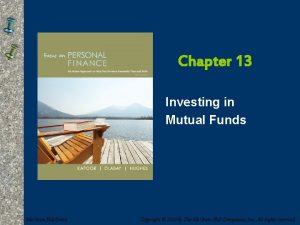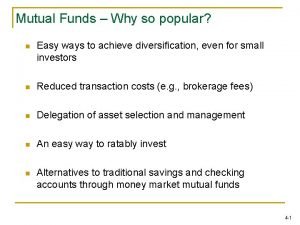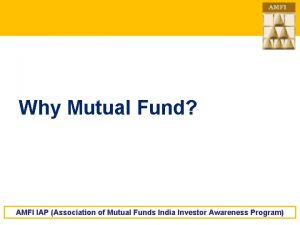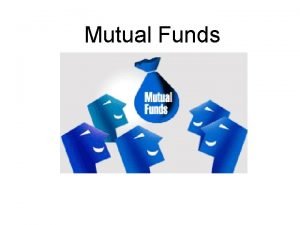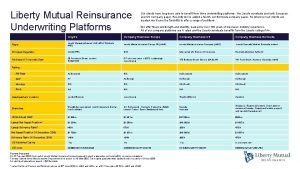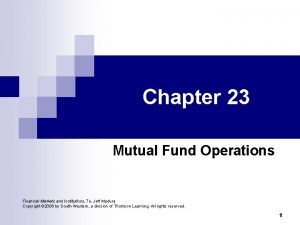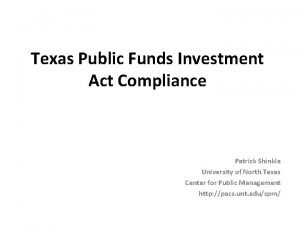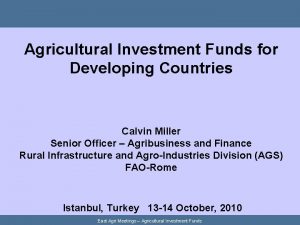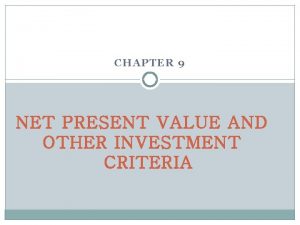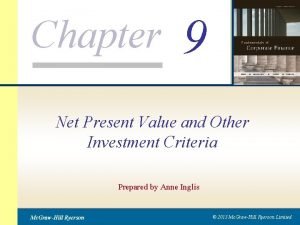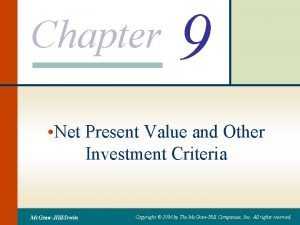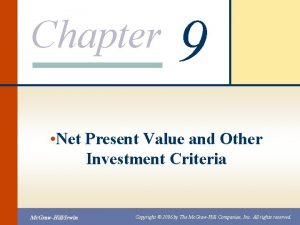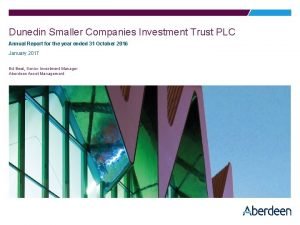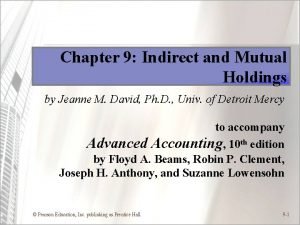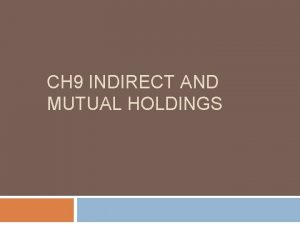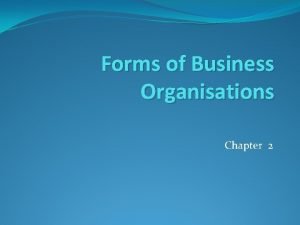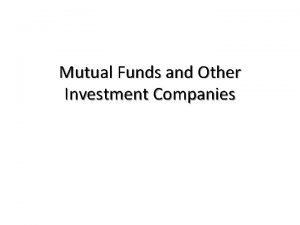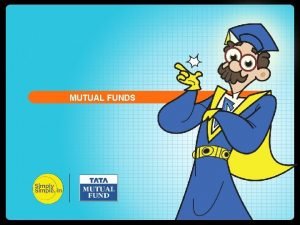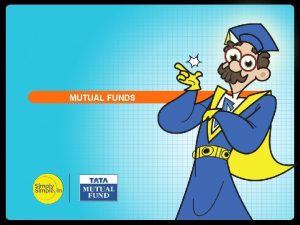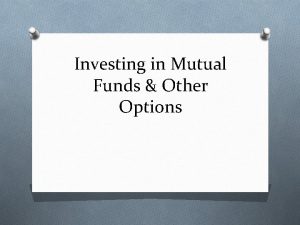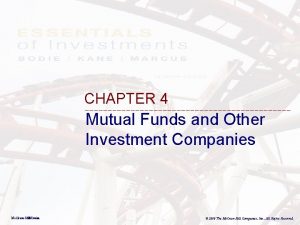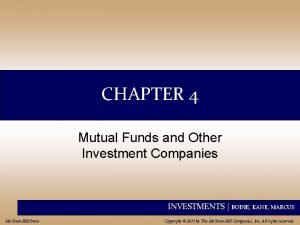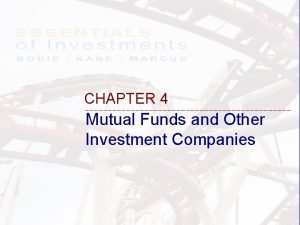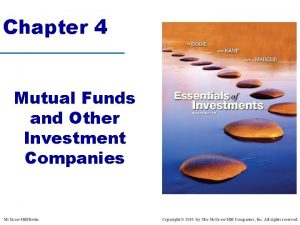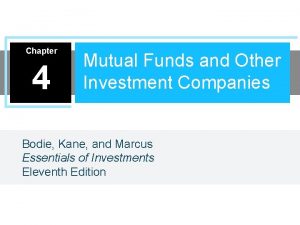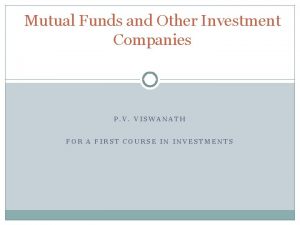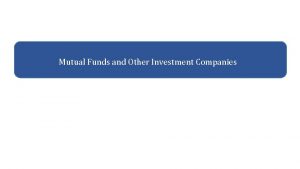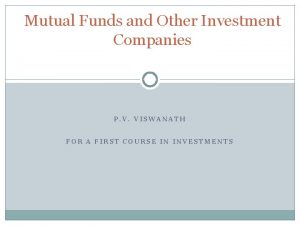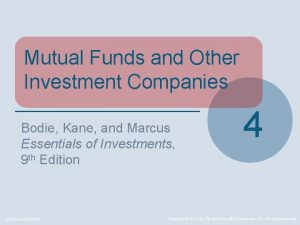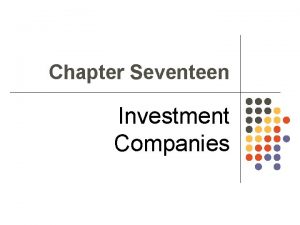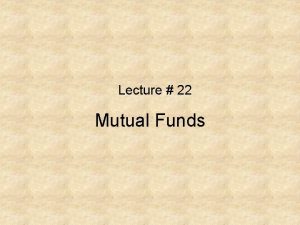Chapter 4 Mutual Funds and Other Investment Companies





















- Slides: 21

Chapter 4 Mutual Funds and Other Investment Companies Mc. Graw-Hill/Irwin Copyright © 2010 by The Mc. Graw-Hill Companies, Inc. All rights reserved.

4. 1 Investment Companies 4 -2

Services of Investment Companies a. Administration & record keeping v Tax purposes v Low cost reinvestment v Low cost additional investment, DCA Low cost switching between fund v families v Some funds may allow check writing privileges 4 -3

Services of Investment Companies b. Diversification § Low cost, instant diversification c. Professional management § Lower research costs managed according to specific objectives § Portfolio to find undervalued securities § Professionals and/or engage in asset allocation strategies d. Reduced transaction costs e. Investing for retirement: Most funds can be set up as an IRA 4 -4

4. 2 Types of Investment Companies 4 -5

Organizational Forms Unit Investment Trusts (UITs): unmanaged, fixed composition portfolios v Any interest and/or dividends are distributed immediately to trust certificate holders. v Provide diversification within one sector or area and low cost entry. v Often levered, rates of return can be extreme. 4 -6

Organizational Forms Managed Investment Companies: Managed, usually changing composition portfolio. v __________________ More commonly known as a ‘mutual fund’ v The fund's board of directors typically hires an investment advisor to select and manage the fund assets according to some specific goal(s) set by the board any regulatory requirements. v The investment advisor usually creates the fund and selects the investments. Most funds are of this type. 4 -7

Organizational Forms • When the holder of the UIT wants to cash out: • Investors who wish to liquidate their holdings of a unit investment trust (cash out) →may sell the shares back to the trustee for net asset value. • The trustees can either: • 1 - Sell new securities from the portfolio to obtain the cash to pay the investor, • 2 -or they may instead sell the old shares to a new investor (again at a slight premium to net asset value). • 4 -8

Organizational Forms Managed Investment Companies: Managed, usually changing composition portfolio. v __________________ More commonly known as a ‘mutual fund’ v The fund's board of directors typically hires an investment advisor to select and manage the fund assets according to some specific goal(s) set by the board any regulatory requirements. v The investment advisor usually creates the fund and selects the investments. Most funds are of this type. 4 -9

Organizational Forms A managed investment company (mutual fund) may be v Open end – shares are bought from the fund and redeemed by the fund or v Closed end – shares are bought and sold among investors in the marketplace 4 -10

Closed End Mutual Funds 4 -11

Close-end fund • • fixed amount of shares through an (IPO). traded on exchange market Thus, do not redeem or issue shares. Investors who wish to cash out must sell their shares to other investors(not redeemable) • Market price above the NAV→ trade at premium (selling at premium to NAV) • Market price below the NAV→ trade at discount (selling at discount to NAV) • Pontiff (1995) estimates that a fund selling at a 20% discount would have an expected 12 -month return more than 6% greater than funds selling at net asset value.

Open-end fund • redeem or issue shares at their net asset value • does not have restrictions on the amount of shares the fund will issue • Investors who wish to “cash out” their shares, they sell them back to the fund at NAV. • Thus, Do not trade in the exchange markets. • the price cannot fell below the NAV • The price can exceed the NAV (load)

Open-End and Closed-End Funds: Key Differences Shares Outstanding v Closed-end: no change unless new stock is offered v Open-end: changes when new shares are sold or old shares are redeemed Pricing v Open-end: Fund share price = Net Asset Value (NAV) v Closed-end: Fund share price may trade at a premium or discount to NAV 4 -14

First Look at Mutual Fund Performance v Evidence shows that average mutual fund less than broad performance is generally ____ market performance v Evidence suggests that over certain horizons some persistence in positive performance ________ Some inconsistencies 4 -15

Other Investment Organizations • There are intermediaries not formally organized or regulated as investment companies but serve functions similar to investment companies. Among the more important are : 1 -Commingled funds • similar in form to open-end mutual funds. Instead of shares, though, the fund offers units, which are bought and sold at net asset value. • Bank or insurance company (management firm), manages the funds for a fee. •

Other Investment Organizations 2 -Real Estate Investment Trusts (REITs): • Similar to closed end fund. Invest in real estate and real estate loans. • Kinds: • Equity trusts purchase real estate • Mortgage trusts invest in mortgage and construction loans secured by real estate. • Raise capital: by borrowing from banks and issuing bonds or mortgages. So, most of them are highly leveraged, with a typical debt ratio of 70%. • Taxation: REITs are exempt from taxes as long as at least 95% of their taxable income is distributed to shareholders 4 -17

Other Investment Organizations Cont. 3 -Hedge Funds • Similar to mutual funds, but not registered and not subject to SEC regulations. • Available to institutional and high net worth investors • Lock-up • their managers can apply some investment strategies that it’s not applicable to mutual fund managers 4 -18

Net Asset Value Used as a basis for valuation of investment company shares – Selling new shares – Redeeming existing shares Calculation 4 -19

NAV calculation ABC Fund ($Millions except NAV) Market Value Securities + Cash & Receivables - Current Liabilities NAV Total # Fund Shares NAV $550. 00 75. 00 (20. 00) $605. 00 Most Mutual Funds have little or no Long Term Debt 20. 00 $ 30. 25 4 -20

Problem 3 NAV = (Market Value of Assets – Liabilities) Shares Outstanding A. (200, 000)x($35) = $ 7, 000 Liabilities B. (300, 000)x($40) = $12, 000 $30, 000 C. (400, 000)x($20) = $ 8, 000 D. (600, 000)x($25) = $15, 000 Shares Outstanding $42, 000 4, 000 $42, 000 – $30, 000 = $10. 49 = NAV 4, 000 4 -21
 Chapter 13 investing in mutual funds
Chapter 13 investing in mutual funds Mutual funds examples
Mutual funds examples Iap mutual funds
Iap mutual funds Mutual funds disclaimer
Mutual funds disclaimer Mutual fund disclaimer
Mutual fund disclaimer Meritas mutual funds
Meritas mutual funds Reinsurance mutual funds
Reinsurance mutual funds Mutual fund operations
Mutual fund operations Aim mutual funds
Aim mutual funds Mutual funds market watch
Mutual funds market watch Public funds investment act training
Public funds investment act training Calvin miller coltivare
Calvin miller coltivare Advantages and disadvantages of payback method
Advantages and disadvantages of payback method Chapter 9 net present value and other investment criteria
Chapter 9 net present value and other investment criteria Npv profiles
Npv profiles Chapter 9 net present value and other investment criteria
Chapter 9 net present value and other investment criteria Dunedin smaller companies investment trust
Dunedin smaller companies investment trust Fixed investment and inventory investment
Fixed investment and inventory investment Indirect and mutual holdings chapter 9
Indirect and mutual holdings chapter 9 Indirect and mutual holdings
Indirect and mutual holdings Other initiated other repair
Other initiated other repair Three companies in business chapter 2
Three companies in business chapter 2
